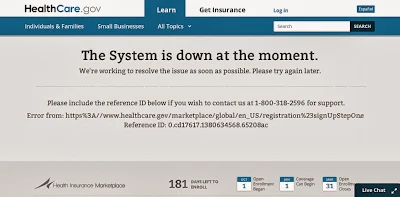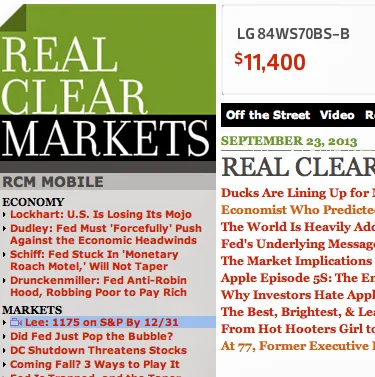So suggests JT Young, who makes a plausible, although strictly political argument,
here, for why Obama might want a debt default:
[T]he last time Obama faced Congressional Republicans in a debt limit fight, he lost enormously. ... However the roots of the administration's non-negotiating stance may run deeper than just that last defeat. It is not just a repeat of the past it must avoid, but a continuation of the present. ... Obamacare is hardly the worst of the administration's PR problems. According to a Bloomberg News national poll released 9/25, Obama's approval rating on the economy is negative, with 38% approving to 56% disapproving. On the federal deficit, it is -32% (29% to 61%). On the recent Syria sidetrack, his rating is 31% - 53%. ... It is clear that nothing the administration wants is likely to move over the next three years. Historically, the president's party generally loses seats in midterm elections - particularly second midterms - so the president's legislative situation is only likely to worsen. Should it do so, the president's political fortunes and popularity are sure to follow. In sum, there appears to be no variable that will change the chessboard. ... [T]he president's only hope appears to stake everything on a single move. In this case, it appears the move is to goad Congressional Republicans into a dramatic loss in a high-profile - and ideally prolonged - budget battle. That means a shutdown or worse, default, to discredit his opposition - in his best case scenario, to such an extent that he reverses the trend of normal midterm losses and the rapid decline of second term presidents' political relevancy. With his second term initiatives dead early, fighting a continuous rearguard action on his signature achievement, anticipating the loss of additional Congressional seats, and with lame duck status just over a year away, the White House may see little to lose by betting large. If so, America could find itself with quite a lot to lose, as this budget fight gets nastier, longer, and more dangerous than anyone anticipated.
---------------------------------------------------------
But what if the non-negotiating stance is more than just political in the conventional sense? What if it's ideological in a more sinister way? What if Obama really means to transform the country not just by eliminating Republicans, who are the political representatives of the middle class, but by eliminating the middle class itself? And capitalism in the process? And using the crisis of a default to install himself permanently at the head of the government? Using the impressive means now at his disposal with surveillance capabilities, militarized police who care nothing for the Fourth Amendment as we saw in the Tsarnaev affair, drones, the Department of Homeland Security generally, and the TSA in particular to control travel? And a de-Christianized, paganized military loyal to the commander in chief?
As all students of communist revolution know, it is the middle class which is the greatest enemy of the communists because being more numerous than the upper class the middle class stands in the way of the revolutionaries' attacks on the rich and on private property as a concept. "Their special interests are absolutely incompatible with the economic disturbances which are the inevitable accompaniment of transitional periods. The disturbance of credit cuts the ground from under their feet. They begin shouting for order, for the strengthening of credit, in such a way that every concession to them leads in effect to a complete restoration of the old order", wrote Bela Kun in 1918.
Make no mistake. This has been a transitional period in the mind of Obama, who is trying to transform the country in a number of ways which are not in keeping with America's past. For example, despite growing public opposition since March 2010, Obama continues to insist that ObamaCare must be implemented even though he himself has underscored its unpopularity by unilaterally and unlawfully altering and delaying key features of it. The Supreme Court itself has validated its compulsory basis, which the regime constantly trots out as authoritative as any teaching bearing Pontifical imprimatur. But at what cost to the middle class whose numbers continue to shrink? The best estimates show that ObamaCare will force 16 million heretofore middle class Americans into Medicaid, the healthcare system for the country's poor which already has 70 million participants, dramatically reducing their numbers by transforming their condition to dependency on the government. Fully 93% of American wage earners already make less than $100,000 a year, and 75% bring home less than $50,000 annually. Between the two extremes lie barely 30 million people. This week's posterchild for ObamaCare, for example, was a law student who got cheaper healthcare through Healthcare.gov, ObamaCare's new web portal which just opened, because it shunted him into Medicaid because his income is too low to qualify for a subsidized ObamaCare compliant health insurance plan. This was widely viewed as a positive!
The truth is Obama has done nothing to help the middle class even though he claims to be their champion, just as the Affordable Care Act will neither provide care nor be affordable. In fact, one might say Obama has been exacting revenge on the middle class. Even though he's been in charge of the government going on five years, Obama has done nothing to improve middle class incomes, which have instead headed in the other direction under his watch. Annual household income has been reduced by over 5% since June 2009 alone.
Similarly the hallmark of middle class membership, the home ownership rate has been reversed to the 1996 level after 5 million homes have been repossessed by the banks. During Obama's tenure in office the ranks of those not in the labor force have soared above the 90 million mark as the longest unemployment recession in the post-war period appears to have no end in sight nearly 6 years since it began, driving college graduates back home with their parents and dramatically reducing family formation. The credit expansion of the post-war economy upon which home ownership was based has hit a brick wall since 2007 while the powers that be have claimed to fix it while enriching only the bankers and the richest investors. Total credit market debt outstanding is up less than $8 trillion in the interim when by all rights it should be up $25 trillion. We even have so-called right wingers who both applaud this decline of home ownership and enthusiastically agitate for the elimination of the home mortgage interest deduction. They are as much useful idiots to Obama's pinched leftist vision as have been Republican free-traders who helped the investor class get rich by shipping American jobs to cheaper labor markets abroad, gutting American exceptionalism long before Obama came along.
As if all that isn't bad enough, unprecedented financial repression of the savings of the middle class is the official policy of Obama's Federal Reserve through Zero Interest Rate Policy and Quantitative Easing, arresting the basis of the gains which customarily accrue over time from compounding and destroying the incomes of the already retired.
Its main sources of wealth in employment and earning power, housing and savings already severely punished under Obama, the middle class is just an inch away from losing it all in a debt default. And once they are out of the way, there will be nothing standing between Obama and finally spreading the wealth around of the 2-3 million at the top who hold it.
















































